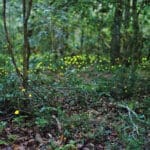 By Julie McConnell, UF/IFAS Extension Bay County
By Julie McConnell, UF/IFAS Extension Bay County
“I never see fireflies anymore, where did they go?” I get asked this a lot and it always catches me by surprise because I see them at my house every summer. Like most things in nature, the answer is not simple because there are several factors that contribute to local insect population levels. Just like attracting other wildlife, it is helpful to understand the life cycle and habitat needs of fireflies to increase the likelihood you will have an enlightening encounter!
Fireflies are also known as lightning bugs but are neither flies (Order Diptera) nor bugs (Order Hemiptera). Fireflies are in the Order Coleoptera (beetles), Family Lampyridae, and there are 56 different species in Florida. Like butterflies, their life cycle is a complete metamorphosis which includes four stages: egg, larva, pupa, and adult. All stages contain bioluminescence substances and may produce a glow. The most recognized function of the firefly’s ability to light up is to attract mates, but there is speculation that the presence in juvenile forms may also deter predation by making them distasteful.
 Adult fireflies signal each other to attract mates and the fertile female lays eggs in the top 1-3 inches of soil in meadows or forested areas dependent on species. In general, the eggs and larvae require moist soil with decaying vegetative material to thrive. Larvae are predators that feed on insects, snails, slugs, and earthworms which are found in decaying organic matter. Without moisture and a food source, the larvae will die. The larval phase can take several years to complete before the firefly pupates and emerges as an adult in the spring or summer. The primary function of adults is to reproduce so they rely on an environment that allows them to attract a mate and lay viable eggs.
Adult fireflies signal each other to attract mates and the fertile female lays eggs in the top 1-3 inches of soil in meadows or forested areas dependent on species. In general, the eggs and larvae require moist soil with decaying vegetative material to thrive. Larvae are predators that feed on insects, snails, slugs, and earthworms which are found in decaying organic matter. Without moisture and a food source, the larvae will die. The larval phase can take several years to complete before the firefly pupates and emerges as an adult in the spring or summer. The primary function of adults is to reproduce so they rely on an environment that allows them to attract a mate and lay viable eggs.
Limiting factors that may interfere with fireflies taking up residence in your landscape:
Light pollution. Outdoor artificial lighting can interfere with the adults’ ability to attract a mate and breed.
Tidy yards. Thatch in your lawn, decaying leaves or mulch, shade-producing shrubs and trees, and undisturbed natural areas are all potential habitats for juvenile fireflies. If there is no vegetative material playing host to food sources, you will not attract females to deposit eggs.
Indiscriminate insecticide use. Excessive use of insecticides can impact fireflies by reducing food sources (remember these bugs eat bugs!). If you have a landscape pest problem, be sure to use integrated pest management (IPM) practices. IPM includes cultural practice changes and using selective insecticides in a targeted rather than broad-spectrum application when needed.
If possible, incorporate some firefly-friendly habitats in your landscape. If that is not possible, make it a point to plan a sunset visit to places where they are likely to congregate and enjoy the light show!
An Equal Opportunity institution, Extension Service, University of Florida, Institute of Food and Agriculture Sciences. Participation shall not be denied on the basis of race, color, religion, sex, national origin, disability, sexual orientation, marital or family status, or political beliefs.





















































